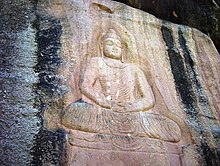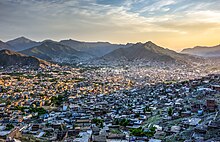Swat District
[8][9] The average elevation of Swat is 980 m (3,220 ft),[5] resulting in a considerably cooler and wetter climate compared to the rest of Pakistan.With lush forests, verdant alpine meadows, and snow-capped mountains, Swat is one of the country's most popular tourist destinations.Swat Kohistan forms the larger, northern part of the district, and is mainly inhabited by the indigenous Kohistani, Torwali and Kalami peoples.Swat Proper forms the lower portion of the district and has a Pashtun majority, with a significant Gujar population.The Swat River whose headwaters arise in the 5,500-to-5,800-metre-tall (18,000–19,000 ft) Hindu Kush mountain range runs through the length of the region.Swat's lower reaches have vegetation characterized by dry bush and deciduous trees, while the upper areas mostly have thick pine forests.The runway is situated between Swat River and the Sham Baba mountainous range, with lush green gardens and large trees being added as "charm" to the climate in the area.The Kanju village has seen an influx of academics in the region and is considered a hub for the Matta and Kabal Tehsils of Swat Valley.In 327 BCE, Alexander the Great fought his way to Odigram and Barikot and stormed their battlements; in Greek accounts, these towns are identified as Ora and Bazira.[27] Following the death of the most famous Indo-Greek king, Menander I around 140 BCE, the region was overrun by the Indo-Scythians, and then the Persian Parthian Empire around 50 CE.[4][5] Hindu Shahi rulers built fortresses to guard and tax the commerce through this area,[40] and ruins dating back to their rule can be seen on the hills at the southern entrance of Swat, at the Malakand Pass.Swat continued to exist as an autonomous region until it was dissolved in 1969,[44] and incorporated into Khyber Pakhtunkhwa Province (formerly called NWFP).The region was seized by the Tehrik-i-Taliban in late-2007,[8] and its highly-popular tourist industry was subsequently decimated until Pakistani control was re-established in mid-2009 after a month-long campaign.[9] During their occupation, the group attacked Nobel laureate Malala Yousafzai in 2012, who at the time was a young school-girl who wrote a blog for BBC Urdu detailing life under Tehreek-i-Taliban rule, and their curb on girls' education.Kushan-era Buddhist stupas and statues in the Swat Valley were demolished by the Tehreek-i-Taliban,[45] and the Jehanabad Buddha's face was blown up using dynamite,[46][47] but was repaired by a group of Italian restorers in a nine-year-long process.In the 2002 National and Provincial elections, the Muttahida Majlis-e-Amal (MMA), an alliance of religious political parties, won all the seats.






DistrictMahodand LakeGabin JabbaSwat RiverSwitzerlandKhyber PakhtunkhwaPakistanProvinceDivisionMalakandCapitalSaidu SharifMingoraTehsilsDeputy CommissionerTime zoneArea codePashtoKohistani languagesTorwaliKalamiMalakand Division2023 national censusBuddhismGandharaGandharan Buddhismconquest of SwatYousafzaisPashtunizationSaidu BabaState of SwatPrincely stateBritish suzeraintyBritish RajPartition of British Indiaindependence of PakistanDominion of PakistanWest PakistanNorth-West Frontier Provincewas seizedTehrik-i-Talibanwas re-established in mid-2009alpine meadowsFaxianSwat KohistanKohistaniPashtunChitralUpper DirLower DirGilgit-BaltistanKohistanShanglatehsilHindu KushBahrainMatiltanGabralPanjkora RiverIndus RiverPeshawar valleyKalam ValleyMadyanSwat ValleyChakdaraSaidu Sharif AirportKabal TehsilsFalak SarJarogo WaterfallGandhara grave cultureOddiyanaGandhara civilizationAlexander the GreatOdigramBarikotGreek accountsSeleucus I NicatorBuddhalotus throneMauryanAshokaGreco-BactriansScythiansCentral Asian SteppeBajaurIndo-Greek KingdomMenander IIndo-ScythiansParthian EmpireGreco-Buddhist artKushansKanishkaMahayana BuddhismFa-HsienButkara StupaAmlukdara StupaNemogram StupaSwat MuseumHephthalite bowlKidariteAlchonAlchon HunsMihirakulaShaivismHinduismSong YunXuanzangHindu ShahiUdigramtemplesSanskritlingua francaMuslim conquestsMuslimMalakand PassMahmud Ghaznavi MosqueJayapalaBattle of Peshawar (1001)Mahmud of GhazniSultanate of SwatDardicYousafzaiAkhund Abdul GaffurAkhundsBritish Indian Empireacceded